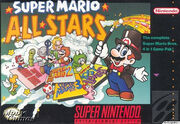 | |
| Super Nintendo Entertainment System (SNES) | |
 
| |
| Manufacturer | Nintendo |
| Type | Console |
| Release Date | November 21, 1990 (JP) August 13, 1991 (USA) April 11, 1992 (EU) June 19, 1992 (Canada) July 3, 1992 AU) |
| Discontinued | |
| Media | Cartridge |
| Save Format | None |
| Input Options | 2 Super Nintendo compatible gamepads |
| Special Features | |
| Units Sold | 49 million |
| Top Selling Game | Super Mario World |
| Variants | FC Twin Retro Duo FC 3 Plus FC 16 Go |
| Competitor(s) | Sega Genesis |
| Predecessor | Nintendo Entertainment System, Famicom |
| Successor | Nintendo 64 |
The Super Nintendo Entertainment System (often shortened to Super NES or SNES) was released in North America in August 13, 1991 after the design was retooled from the Japanese Super Famicom. The European version, however, retained the look and design of the Super Famicom. The system was a powerful update to the NES/Famicom. The system initially came with Super Mario World as a bundled game but later in its life this was changed to Donkey Kong Country.
System Information
The SNES was a 16-bit console and therefore had better graphics than its predecessor, the Nintendo Entertainment System (NES). It was quite a revolutionary console at the time and the 16-bit graphics made many of the games more pleasing to the eye.
Advertising and Competition
The SNES was competing with the Sega Genesis/Megadrive. The SNES had a slogan like most gaming consoles at the time. The SNES slogan at the beginning of its market life was "Now you're playing with power -- SUPER power!", which was a modified version of the NES' usual slogan. This was later changed around 1994 with "Play it loud!" The SNES originally came either with one controller and no pack-in cartridge or with two controllers and Super Mario World as its pack-in cartridge.
Games
The SNES like its predecessor had a huge library of games including Super Mario All-Stars, Mortal Kombat, Street Fighter II, Teenage Mutant Ninja Turtles IV: Turtles in Time, Star Fox (Starwing in Europe) and The Legend of Zelda: A Link to the Past. These games were all very well known at the time and were often spoken of in the way people speak of, say: Halo 3, Call of Duty 4: Modern Warfare and Gears of War. Many of the games on the SNES were later ported to the Game Boy Color and the Game Boy Advance as these two handheld consoles were capable of holding the 16-bit graphics of the SNES.

Super Mario All-Stars (SNES)
Connectivity
The SNES in America had one major expansion unit that was released in America: the Super Game Boy accessory. By plugging a Game Boy cartridge into the accessory and then plugging it into the SNES cartridge slot, SNES owners could play Game Boy cartridges on their TVs with limited but alterable color capabilities. Some Game Boy cartridges were released as "Super Game Boy compatible" games which unlocked special features and game screen frames contained in the cartridges when used with the accessory.
Nintendo had intended for the release of a CD-ROM adapter that would give the system expanded gaming capabilities similar to or greater than its competitors, the Sega Genesis with its Sega CD and the TurboGrafx-16 with its TurboCD. It formed brief alliances with both Sony and Philips for the purposes of bringing forth this adapter, but nothing came to fruition as far as its development. Sony would go on to develop its first gaming system, the Playstation, that would compete with the Nintendo 64 while Philips released its CD-i with a few titles featuring Mario and Legend of Zelda characters.
Launch Titles
- Super Mario World
- F-Zero
- Pilotwings (USA Launch)
See also
- List of SNES games
- SNES games
